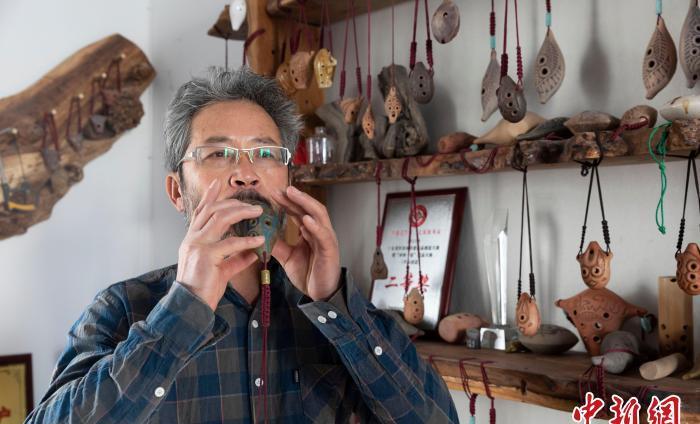
Yang Dawude blows mud wow. Photo by Yang Di
Zhongxin Network Yinchuan December 18 Title: Ningxia Non-Hereditary Inheritors: Ingenious Craftsmanship Makes The Thousand-Year-Old Sound "New Sound"
Author Yang Di Zhang Yue
Niwa Woo is a kind of ethnic musical instrument circulating in Ningxia Hui Autonomous Region, because it is made of glue clay, and the tone played by the two holes is similar to "Wa" and "Woo", so it is called "Ni Wa Woo".
Yang Dawude makes mud wow. Photo by Yang Di
The history of Niwa Woo has been around for thousands of years, dating back to the Western Xia Dynasty. The original form of mud wow wow only two holes, the pronunciation is monotonous, and now, after the skillful hand of non-genetic heirs, this instrument named after the "sound" is re-issuing a "new sound".
Recently, the reporter of China News Network followed Yang Dawude, the inheritor of the national intangible cultural heritage niwawu project, to understand the inheritance and innovation of niwawu.
Yang Dawude shows a fish bird type mud wow. Photo by Yang Di
Walking into Yang Dawude's studio, the exhibition shelves are filled with mud of different colors and shapes. "Due to the different kneading methods, the mud wow has formed four major shapes: bull head type, horn type, fish bird type and lentil type." Yang Dawude introduced that in ancient times, the mud wow was a tool to transmit signals during the war, and now it has evolved into a wind instrument, and in 2006 it was included in the national intangible cultural heritage protection list.
Yang Dawude was born into a mud-wah-wah-making family. "Making mud is my family craft, and my father once told me that this is a craft that has been handed down from generation to generation, and I want to pass on its sound."
Influenced by his family, Yang Dawude also formed an indissoluble relationship with the production and blowing of mud wow. At that time, due to the small number of sound holes and narrow sound range, the mud wow was only a folk instrument that "entertained itself". To this end, Yang Dawude began to transform the instrument.
To make the range of mud whimper wider, it needs to have more pronunciation holes. In 2001, Yang Dawude successfully improved the wide range of mud wow, and now, mud wow has developed to 10 holes, can be freely transposed, play a variety of repertoire.
To make a piece of mud, it is necessary to go through multiple processes such as material selection, grinding, mud, rotting, blank repair, tuning, yin drying, firing, etc., and its raw materials are made from the common yellow glue mud in Ningxia. When playing mud and whining, its voice is deep and "earthy", as if it is connected with the soul of the land under his feet, and the local feelings in it also make Yang Dawude determined to promote this national instrument.
In the early days, mud wowing could only be kneaded by hand, and there was no uniform modulation. After continuous research, Yang Dawude successfully developed the compound mold technology, so that the mud wow to achieve large-scale production, with a unified pitch, convenient for its promotion.
In recent years, Yang Dawude has made Niwa wu known to more people through activities such as "non-heritage into the campus". At the same time, he also set his sights on overseas, and through foreign cultural exchange activities, he brought mud to Japan, Australia, New Zealand, Pakistan, the United Arab Emirates and other countries, which was welcomed by the local people.
At present, Yang Dawude plans to build a mud wah museum in the local area, and he hopes to show more people the mud wah and let people feel the charm of this instrument immersively. (End)